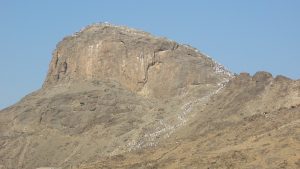A mountain in Arabia is responsible for what statisticians say will be the world’s largest religion by about 2070 unless something drastic happens. In that regard, we must give credit where it’s due—this mountain is, without question, the site of the most successful supernatural PSYOP in history.

The Arabic name of this peak means “Mountain of Enlightenment.” Jabal al-Nour is near Mecca in western Saudi Arabia. It’s the site of the cave where Muhammad was visited by an angel calling itself Jibril, or Gabriel.
There is no way to sugarcoat this: The message was not from God. Yahweh does not contradict Himself, but the Quran clearly does. Muhammad saw something, of that we have no doubt. But it was not a messenger from Yahweh.
Islam has a role to play in the future war for God’s holy mountain. Sadly for Muslims, the part the Fallen wants them to play is very simple—to die.
Allah is the name used for the god of Islam, but it’s also the name used by Arab Christians for the God of the Bible. This is somewhat confusing, which is, of course, intentional. Just as El was the name of the chief god of the Canaanites and a generic name for God in Hebrew, “Allah” is another PSYOP by the Fallen to muddy the water.
Many Christians assume that Muslims worship the same god they do, and so they aren’t surprised to learn that Arab Christians apply the same proper name to the God of the Bible. This is the same mistake as assuming a pagan Amorite in the 15th century BC who prayed to El was calling on the God of Abraham, Isaac, and Jacob. Muslims, who believe that Allah has no son, have put their faith in something they think is the God of the Book (the Bible). How can that be, when there are fundamental differences between Allah and Yahweh?
Some Christian scholars draw a link between Allah and older deities worshiped in Arabia prior to Muhammad. This isn’t universally accepted, but it doesn’t have to be to make a case for the god of Islam being something other than Yahweh.
Etymologically, the explanation that seems to make the most sense, and the one accepted by most scholars, suggests that Allah is a contract of al-lāh, “the god.” That’s like the old Semitic use of El, a proper name that grew out of the generic Proto-Semitic word ʾil-, meaning “deity” or “god.” Variant forms show up in Akkadian (ilu), Ugaritic (il), and Hebrew (eloah, the singular form of elohim).
Still, differences in the fundamental characteristics of Allah and Yahweh force us to conclude that one of two things must be true: Either, 1) Allah and Yahweh are one and the same, and the Bible doesn’t accurately record the way Yahweh revealed Himself to the prophets and apostles; or, 2) some thing lied to Muhammad in that cave on Jabal al-Nour, and Allah is not the God of the Bible.
Given that we have Old Testament texts that can be reliably dated to at least two centuries before Jesus (the Septuagint translation from Hebrew into Greek), and most scholars would accept earlier dates for the authorship of those books, and that the books of the New Testament are the best attested documents from the classical period, there is compelling evidence that the Bible has not been corrupted or substantially changed since it was written by the apostles and prophets. While there are minor differences between some texts, the sheer number of manuscripts and documents that quote scripture, like letters from the early church fathers, provide plenty of material to cross-check the books of the Bible and confirm its reliability.
In contrast, the Quran was compiled into its final form about twenty years after the death of Muhammad from several competing versions. By the time of the third caliph, Uthman ibn Affan, Islam had spread from Arabia into Iraq, Syria, Egypt, and Iran, cultures that were different from one another and from the origin point of the faith. Uthman was reportedly motivated to take on the project by disputes between some of the new followers over the correct way to pray. So, to prevent Muslims from fighting over the book, texts were collected from around the caliphate and compiled into an “official” version, and variant copies were destroyed.
Even Muslim scholars—mainly Shia, who believe that Muhammad’s cousin and son-in-law was the rightful heir to the prophet’s growing empire—admit that Uthman corrupted the Islamic holy book by his action.

There is more to the story, of course. Scholars spend entire careers studying the Quran just as others do the Bible. But the fundamental difference between the Quran and the Bible is that there is no comparison between the two when it comes to the quantity and quality of the source material.
We take no joy in saying so. Literally billions of humans will pay the ultimate price for the supernatural deception worked on a charismatic Arab trader fourteen centuries ago. And billions more will be destroyed in the cataclysmic final battle for the holy mountain of Yahweh. The bloodthirsty gods are preparing for war.
#
Here is where another brief review of history may be helpful. We’ll get a little speculative, and because we’re dealing with the spirit realm there is only so much we can say with one hundred percent confidence.
What happened to the Amorites? Scholars have been exploring that question ever since their existence was confirmed by sources outside the Bible in the 19th century. They were pushed out of Mesopotamia by the Kassites, who took Babylon in the 16th century BC, and native rulers near the Persian Gulf called the Sealand Dynasty. We’ve already discussed how the Amorite Hyksos rulers of Lower Egypt were evicted by native Eygptians around the same time.
They Amorites disappear from history around the time of the Sea Peoples invasion of the Levant and Egypt in the late 13th and early 12th centuries BC. This coincides with what scholars call the Late Bronze Age collapse. Over a period of about fifty years, between about 1200 and 1150 BC, the major states of the eastern Mediterranean from Mycenaean Greece and Hatti to the Amorite and Canaanite states of the Levant were destroyed.
This was the event that ended the kingdom of Ugarit during the reign of the ill-fated Ammurapi we mentioned in an earlier chapter. A small kingdom southeast of Ugarit called Amurru, named for the Amorites, was also wiped out around this time.
This was the period of the later Judges, a time that set the stage for the emergence of the kingdom of Israel. Barak and Deborah’s destruction of Hazor, which some scholars think may have belonged to the kingdom of Amurru, may be dated to this time.
The bottom line is that only Egypt and a few small kingdoms in northern Syria appear to have survived this wave of destruction. The Philistines settled in what we call today the Gaza Strip, and they may have been part of the Sea Peoples coalition. Emerging from the ashes of this turmoil alongside the kingdom of Israel were several Aramean kingdoms, with Damascus and Hamath being the largest.
Because they came out of the same area formerly associated with the Amorites, it’s easy to assume that the Aramean people were just descendants of the Amorites who carried on as best they could after the disasters of the Late Bronze Age collapse. But we can’t make that assumption any more than we could assume that the Israelites were just Canaanites with a repackaged religion because of where David came to power.
By analyzing texts that have been found from the Neo-Assyrian, Neo-Babylonian, and later Egyptian kingdoms, we can piece together a history that seems solid. While the name “Amorite” fell out of use after the conquest of Canaan, there are a couple of tribal names that bridge the period between the disappearance of the Amorites and the emergence of the Arameans. Specifically, the Aḫlamū, sometimes called Aḫlamū-Aramayū (Aḫlamū-Arameans) by the Assyrians, and our old friends the Suteans.
Together, these two tribal names appear to be used, at least sometimes, interchangeably with both Amorite and Aramean nomads, mainly in the steppes of Syria and the Transjordan. After the conquests of the Assyrian empire through the 7th century BC, even the Arameans fade from history, although the Aramaic language, because it was adopted as the lingua franca by Assyria, became the language of trade and cultural exchange in the Near East from about 600 BC to around the time of Jesus before giving way to Greek.
In short, scholars can document a “geographical, historical and linguistic continuity” between the Amorites of the Old Babylonian period and the Arameans of the Middle Babylonian era.[1]
Recent history in the old Amorite homeland, which includes Iraq, Syria, Jordan, and Lebanon, points to a troubled future for the Holy Land. We mentioned earlier the existence of territorial spirits, the main biblical example being the Prince of Persia that tied up the messenger to Daniel for several weeks. We can’t know for certain, but it’s worth mentioning because, as you’ve noticed by now, this author doesn’t put much stock in coincidence, especially where it concerns the Bible and the ongoing spiritual war.
Here are the relevant questions: Can it be just a weird coincidence that the hot spots in the Middle East, especially since the emergence of the Islamic State since the summer of 2014, are a match for the areas defined as the homeland of the Amorites four thousand years ago? Is it just a cosmic accident that the land of the Amorites, especially central and northern Syria, are far more important in the eschatology of Islam than Arabia, the land of Islam’s birth?
Consider the otherwise inexplicable atrocities in the Islamic State’s capital, Raqqa, which lies on the west bank of the Euphrates close by Jebel Bishri, the ancient mountain of the Amorites; or the destruction in Aleppo, called the City of Hadad when it was ruled by Amorite kings in the days of Abraham, Isaac, and Jacob. The prophecies that guide the leadership of the Islamic State focus on lands where the old gods of the Amorites once reigned supreme.
In Iraq, where ISIS is hard pressed at this writing [2016] by Iraqi, Kurdish, Turkish, and American forces in the city of Mosul, analysts at the Combating Terrorism Center at the U.S. Military Training Academy at West Point suggest that ISIS has already prepared a fallback plan in Diyala province if they can’t hang on in Mosul. The analysts feel the terrain and the demographic makeup of Diyala is especially well suited for an ongoing insurgency.[2] That’s the area northeast of Baghdad along the Diyala River toward the Hamrin mountain range, where more than four thousand years ago the doomed Sumerian kings of Ur built their futile Amorite-wall-which-keeps-the-Tidnum-at-bay.
All of this begs the question: What foul spirit has been at work in MAR.TUki, the ancient land of the Amorites?
[1] Daniel Bodi, “Is There a Connection Between the Amorites and the Arameans?” ARAM 26/1&2, 2014, 409.
[2] Alex Mello and Michael Knights, “Losing Mosul, Regenerating Diyala: How the Islamic State Could Exploit Iraq’s Sectarian Tinderbox,” Combating Terrorism Center, October 25, 2016 (https://www.ctc.usma.edu/posts/losing-mosul-regenerating-in-diyala-how-the-islamic-state-could-exploit-iraqs-sectarian-tinderbox), retrieved 12/22/16.
